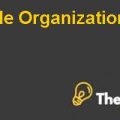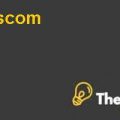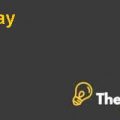Frozen Foods Case Study Solution
DCF Valuation Analysis
A DCF valuation is conducted using the projected balance sheet and income statement for the company’s expansion to evaluate the Net Present Value of the new project on at various investment levels. On the basis of projected cash flows for new investment, the present value of firm is 1916.19 thousands rupees. As there is potential growth in next five years company will earn high profit. Different amounts have taken to calculate NPV of the new project. If the firm will invest 17455.17 so the NPV will be 1500 and if the firm will invest 23455.17 NPV will be negative which is -4500 and if the firm invest 18955.17 NPV will be 0. Firm will get highest NPV when company will invest 14455.75 thousand rupees for expansion of the business because inflows are higher. Table 1 and 2 shows the DCF Valuation and the NPV at various investment levels for Frozen Foods.
Table-1: DCF Valuation
| DCF Valuation | |||||
| Projected | |||||
| 1 | 2 | 3 | 4 | 5 | |
| Revenues | 4400 | 4900 | 5400 | 5900 | 6400 |
| EBITDA | 2000 | 2200 | 2400 | 2600 | 2800 |
| Depreciation | 900 | 945 | 983 | 1016 | 1043 |
| EBIT | 1100 | 1255 | 1417 | 1584 | 1757 |
| EBIT(1-Tax) | 770 | 878.5 | 991.9 | 1108.8 | 1229.9 |
| Add: Depreciation | 900 | 945 | 983 | 1016 | 1043 |
| Less: Capex | 1200 | 1200 | 1200 | 1200 | 1200 |
| Less: Change in Working Capital | 200 | 250 | 250 | 250 | 250 |
| Net Cash Flows | 270 | 374 | 525 | 675 | 823 |
| Discount Rate (WACC) | 10% | ||||
| Discounted Cash Flows | 245 | 308 | 394 | 460 | 509 |
| PV of Cash Flows | 1916.199 | ||||
| PV of Perpetuity | 17038.97 | ||||
| Total PV of Project | 18955.17 | ||||
| Growth | 5% | ||||
Table-2: NPV at Various Investment Levels
| NPV at Various Investment Levels | |||||||
| Investment Levels | 17455.17 | 15955.17 | 14455.17 | 18955.17 | 20455.17 | 21955.17 | 23455.17 |
| PV of Project | 18955.17 | 18955.17 | 18955.17 | 18955.17 | 18955.17 | 18955.17 | 18955.17 |
| NPV | 1500 | 3000 | 4500 | 0 | -1500 | -3000 | -4500 |
From the above Tables, it could be seen that the project could be feasible for the Frozen Foods if it assumes a maximum investment level of $18955.17 where the NPV of the project tends to be zero.
Beta Estimation:
The Frozen Food Products going to establish a new plant because of the increased demand of their product in India. At this time, the Frozen Food Products was not listed in stock exchange. The company faced a difficulty in identifying the risk and returns associated with the product. For this, the company takes the others companies’ information which are similar by nature and by its capital structure. The company gathered the information of the related companies’ that are their equity, debt and equity beta to calculate the debt to equity ratio. The debt to equity ratio is metric used for financial analysis. It indicates the ratio of the debt and equity that how much of company’s operations are run by their debts verses their equity. The following table illustrate the equity, debt, beta along with their debt ratios. And also represent the beta calculated for the frozen company on the basis of other companies’ information.
Table-3: Beta Estimation
| Estimation for Frozen Food's Equity Beta | ||||
| Company | Equity | Debt | Equity Beta | D/E Ratio |
| Advanta India Ltd. | 3744.2 | 5738.3 | 0.5472 | 1.533 |
| Britannia Industries Ltd. | 5200.4 | 281.5 | 0.2638 | 0.054 |
| Glaxo Smith | 11441.8 | 0 | 0.0959 | 0.000 |
| Jubiliant Food | 2995.5 | 0 | 0.9856 | 0.000 |
| Kwality Dairy | 910.5 | 4248 | 0.6357 | 4.666 |
| Rei Agro Ltd. | 23611.8 | 38540.5 | 0.5393 | 1.632 |
| Venky's India | 3157.9 | 985.7 | 0.669 | 0.312 |
| Zydus Wellness | 1868.6 | 0 | 0.5372 | 0.000 |
| Frozen Foods | 6000 | 2000 | ? | 0.333 |
| Unlevered Beta: | ||||
| Equity Beta/ (1+(1-t)*d/e) | 0.549037 | |||
| Levered Beta: | ||||
| Beta levered=unlevered beta* (1+(1-t)*d/e) | 0.445165 | |||
Table 3 indicates the other companies’ debt, equity, equity beta and the calculated debt to equity ratio. All the information was gathered to calculate the company’s beta to calculate the risk associated with the new project. Firstly, the un leveraged beta is calculated then eventually with the help of un leveraged beta, leveraged beta is calculated. The beta representing the amount of 0.4451, this indicate that project has some range of risk associated because the project will be considered safe when the beta ranges from 1 to 1.5.
WACC Calculations:
The WACC is stands for the weighted average cost of capital. It is calculated to analyze the return the company will receive from the new project. The WACC also tells the risk associated with the project. WACC provides the investor with the profitability associated with the project.
Table-4: Determination of WACC
| Determination of WACC | |
| Total Assets | 8000 |
| Total Debt | 2000 |
| Debt Ratio | 25% |
| Equity Ratio | 75% |
| Tax Rate | 30% |
| Cost of Debt | 8% |
| After Tax Cost of Debt | 6% |
| Cost of Equity w-1 | 11.6% |
| WACC | 10% |
The above table shows the WACC calculations. Firstly, beta was calculated. Then with some more information, the cost of equity along with the risk premium was calculated. After that eventually WACC rate is calculated which is valued at 10%. This indicate that the company will require to pay 10% to its investors for their financing.
Recommendations
On the basis of above analysis, Maria is recommended to consider the project if the project investment is not more than $18955 at which the company could expand into new markets without any loss of funds and an NPV of 0. The company is recommended to expand its product line as the expansion could increase the consumer base of the company and could bring potential amount of revenues for the company in future. Moreover, the expansion could decrease the dependency of the firm on its local markets to avoid the negative impacts of any external factor that could occur in the market.
Conclusion
In conclusion, it could be said that the expansion in the new markets within India could bring potential amount of revenues for the firm along with the achievement of large number of consumers and a strong consumer base. Moreover, a the project has a positive NPV at the investment level less than $18955, it could led to an increase in the overall firm’s value and could enable the firm to be a strong player in the market with efficient financial metrics.
Appendices
Appendix-1: SWOT Analysis
| STRENGTHS | WEAKNESSES | OPPORTUNITIES | THREATS |
| · Large domestic market
· Raw material availability · Retained earnings |
· Strong competition
· High R&D cost
|
· Forward integration
· Market development · Organic Food
|
· Worldwide competition
· Threat of substitute · Technological advancement
|
Appendix-2: Porter’s Five Forces Model
| Bargaining Power Of Buyer | Bargaining Power Of Suppliers | Threat Of New Entrants | Threat Of Substitutes | Rivalry Amongst Existing Competitors |
| High | Low | Low | High | High |
| Mass market
Large availability of substitute products Low switching cost
|
Numerous suppliers available
Bulk purchases
|
High growth potential
Intensive capital requirement High competition |
Less switching cost
availability of substitute products changing consumer preferences
|
High number of peers in the market
Technological advancement Governmental policies
|
This is just a sample partical work. Please place the order on the website to get your own originally done case solution.













